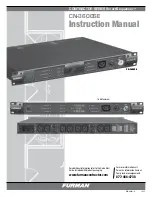
10.3.7.1
Measurement principle
The rate-of-change of the fundamental frequency of the selected voltage is measured
continuously, and compared with the set value,
StartFreqGrad
. Rate-of-change
frequency protection SAPFRC is also dependent on the voltage magnitude. If the
voltage magnitude decreases below the setting
MinValFreqMeas
in the preprocessing
function, which is set as a percentage of a global base voltage parameter, SAPFRC is
blocked, and the output BLKDMAGN is issued. The sign of the setting
StartFreqGrad
, controls if SAPFRC reacts on a positive or on a negative change in
frequency. If SAPFRC is used for decreasing frequency that is, the setting
StartFreqGrad
has been given a negative value, and a trip signal has been issued, then
a 100 ms pulse is issued on the RESTORE output, when the frequency recovers to a
value higher than the setting
RestoreFreq
. A positive setting of
StartFreqGrad
, sets
SAPFRC to START and TRIP for frequency increases.
To avoid oscillations of the output START signal, a hysteresis has been included.
10.3.7.2
Time delay
Rate-of-change frequency protection SAPFRC has a settable definite time delay,
tTrip
. .
Trip signal issuing requires that the rate-of-change of frequency condition continues
for at least the user set time delay,
tTrip
. If the START condition, with respect to the
measured frequency ceases during the delay time, and is not fulfilled again within a
user defined reset time,
tReset
, the START output is reset, after that the defined reset
time has elapsed. Here it should be noted that after leaving the hysteresis area, the
START condition must be fulfilled again and it is not sufficient for the signal to only
return back into the hysteresis area.
The RESTORE output of SAPFRC is set, after a time delay equal to the setting of
tRestore
, when the measured frequency has returned to the level corresponding to
RestoreFreq
, after an issue of the TRIP output signal. If
tRestore
is set to
0.000
s the
restore functionality is disabled, and no output will be given. The restore functionality
is only active for lowering frequency conditions and the restore sequence is disabled
if a new negative frequency gradient is detected during the restore period, defined by
the settings
RestoreFreq
and
tRestore
.
10.3.7.3
Blocking
Rate-of-change frequency protection (SAPFRC) can be partially or totally blocked,
by binary input signals or by parameter settings, where:
BLOCK:
blocks all outputs
BLKTRIP:
blocks the TRIP output
BLKREST:
blocks the RESTORE output
1MRK502052-UEN B
Section 10
Frequency protection
555
Technical manual
Summary of Contents for Relion REG670
Page 1: ...Relion 670 series Generator protection REG670 2 0 IEC Technical manual ...
Page 2: ......
Page 44: ...38 ...
Page 58: ...52 ...
Page 80: ...74 ...
Page 106: ...100 ...
Page 482: ...476 ...
Page 548: ...542 ...
Page 570: ...564 ...
Page 600: ...594 ...
Page 608: ...602 ...
Page 630: ...624 ...
Page 862: ...856 ...
Page 1094: ...1088 ...
Page 1226: ...1220 ...
Page 1250: ...1244 ...
Page 1297: ...1291 ...














































